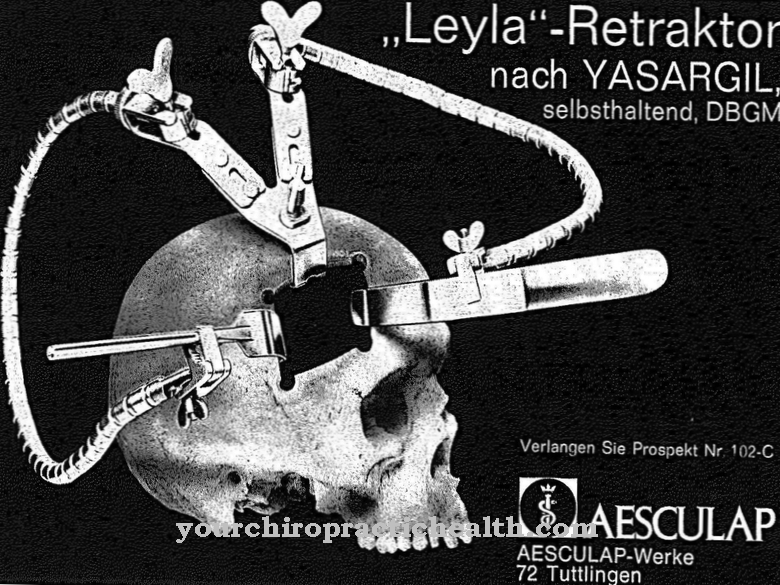In the Osteotomy it is a surgical procedure that is used to correct bone deformities. Often it is a misalignment of the leg, foot or jaw bones.
What is the osteotomy?

The basic principle of the osteotomy is the controlled cutting of one or more bones. Then the operative straightening takes place by means of an osteosynthesis. The previously severed bones are reconnected, with the aim that they grow back together in the corrected shape.
Often an osteotomy is performed to correct bow or knock knees as well as malpositions of the hips. In this case, one speaks of an adjustment or correction osteotomy. In dental surgery, osteotomies are usually used to reposition the jawbone. These jaw osteotomies are used for severe jaw malformations. An osteotomy may also be required when removing wisdom teeth, as wisdom teeth are often stuck in the bone. In the broadest sense, one speaks here of a jaw osteotomy.
Function, effect & goals
One of the most frequently used osteotomies is the derotation variation osteotomy, which is mainly used for hip misalignments. Here, the thigh bone is severed at a certain point, a small bone wedge is removed and the two bone parts that have arisen are screwed together again with a metal splint. If such a hip deformity is not corrected with an osteotomy, there is a risk of osteoarthritis due to incorrect loading of the hip joint.
If the lower leg deviates too far inwards, one speaks of a varus position of the lower leg. This misalignment creates a deformity of the knee joint, so that the malalignment can lead to early arthrosis. To prevent osteoarthritis, the shinbone is cut just below the knee joint. Here too, a piece of the bone is removed to correct the misalignment of the lower leg. The two pieces of bone of the tibia are put back together again by means of plate fixation or clamps. If the procedure is carried out early, the use of an artificial knee joint can be delayed by several years. This procedure is also known as a tibial head osteotomy and is often used to correct bowlegs.
Another method of osteotomy, the Maquet-Bandi operation, is also used for knee joint problems. Here the point of attachment of the hamstring is moved to the side and forward and fastened there with screws. If patients suffer from hallux valgus, i.e. a crooked big toe, a swivel osteotomy of the metatarsal bone is usually performed. The first metatarsal bone is surgically cut, the misalignment is corrected and the bone is then fixed again using a perforated plate so that, ideally, the big toe is straightened again after the operation. A variant of the swivel osteotomy is the scarf osteotomy, which is also used for hallux valgus correction.
The usual procedure for correcting different leg lengths is the extension osteotomy. Unequal leg lengths can be congenital or caused by accidents. While differences of up to two centimeters in leg length can still be compensated for with appropriate orthopedic footwear, if there is a difference of four centimeters, an operative lengthening of the shorter leg is often necessary. The most common procedure here is a so-called callus distraction. The surgeon cuts the bone to be lengthened transversely and inserts a distractor, i.e. a spreader, into the gap between the two bone parts.
To do this, small pins are attached to the bone and connected to a holding system from the outside. This distractor can be used to slowly pull apart the bone fragments. Once the desired lengthening has been achieved, a plate fixation is usually carried out, i.e. the bone pieces are connected to a steel plate. The femoral neck osteotomy is part of the surgical procedure for inserting a hip prosthesis. The entire femoral head is removed here. This can also be indicated for infections of the hip joint.
Osteotomies are rarely performed on the spine. In the procedure, also known as laminectomy, the vertebral arch of one or more vertebral bodies is removed along with the spinous process. This creates space for operations on the spinal cord or intervertebral discs. Even if tumors in the spinal canal cause great pressure on the spinal cord, a laminectomy can be helpful to relieve the corresponding region.
Risks, side effects & dangers
Since the osteotomy is a surgical procedure, the general surgical risks naturally also apply here. These include hard-to-control bleeding and secondary bleeding, infection of the surgical wound (possibly even with multi-resistant germs) and damage to adjacent tissue structures. Osteotomies in the legs in particular lead to immobility for a while.
This can cause clots (thrombi) to form in the deep veins of the legs. This so-called thrombosis carries the risk of pulmonary embolism. The clot migrates via the blood vessels into the lungs, where it leads to a vascular blockage. In the case of very small vessels, the pulmonary embolism can be symptom-free; if a large vessel is occluded, there is an acute risk of death.
Another typical surgical risk is narcotization. About a third of all patients react to the anesthesia with nausea or vomiting. In addition, it can lead to disorders of the cardiovascular system and, in the worst case, cardiac arrest. Artificial ventilation during surgery can also cause difficulty swallowing or hoarseness.
In addition to these general risks, the osteotomy procedure has other specific risks and complications. Osteotomies in the hip area can result in different leg lengths. However, these can usually be compensated for with orthopedic insoles. The fixations that are used for stabilization after the bone has been severed can rarely break. In addition, the materials that are used for the fixation are not protected against wear and may have to be replaced in subsequent operations. In rare cases, the fixations used can also lead to pressure pain.












.jpg)



.jpg)










.jpg)
